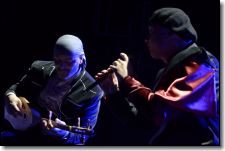|
Georgian folk songs
Georgian folk songs are exceedingly old, and are likely to go back to pre-Christian time. They have always existed in close relation to social, religious and cultural institutions in the Georgian society. Over the centuries the Georgian folk songs have been orally handed down from master to pupil and from group to group through generations. They reflect all sides of society through history with the thematic ranging from religion, humor and love to work, travel and war.
Georgian folk songs are usually three-part songs charac- terized by improvisation, polyphony and strong melodic lines. The improvisation can range from small differences in the interpretation to substantial variations in motifs and themes. The polyphony is often reflected in contrast bet- ween the three voices: They may have specific “musical tasks” and expressions which are totally different from one and each other. The most challenging technical and musical parts are often taken care of by soloists.
Georgian folk instruments
Georgia's folk instrument-tradition is both a separate instru-mental tradition and also a tradition where instruments are used as accompaniment for folk songs and folk dances.
|
|
Here we will briefly mention the most common instru- ments. Panduri is from the eastern part of Georgia and is a three-string lute with frets. The Georgian Chonguri is a fretless 3 string instrument with the 4th string starting from the middle of the neck. Panduri and Chonguri are used both for instrumental music and as accompaniment for the folk songs. Salamuri is a small wooden wind-instrument made from walnut or apricot trees. Sometimes the performer plays with two salamuris in harmony, one in each hand. Finally we will mention the doli or dapdapi, in Georgian. This is a wooden cylindrical percussion-instrument bound with leather.
Georgian folk dance
The Georgian folk dances cover the range from the most caressing and tender to battle-like dances with sparking swords and shields. The folk dances are accompanied either by folk songs or national folk instruments. The survival of pagan traditions in certain remote areas has certainly also added to the uniqueness and diversity of the folk dance tradition of different regions. The Georgian folk dance reflects the tradition of its region and is performed in their respective national customs.
|

Musicians in the folk ensemble Egari. Photo: Egari © all rights reserved.
|

Georgian folk dance with ensemble Erisioni. Photo: Badri Vadachkoria © all rights reserved.
|
|
|













